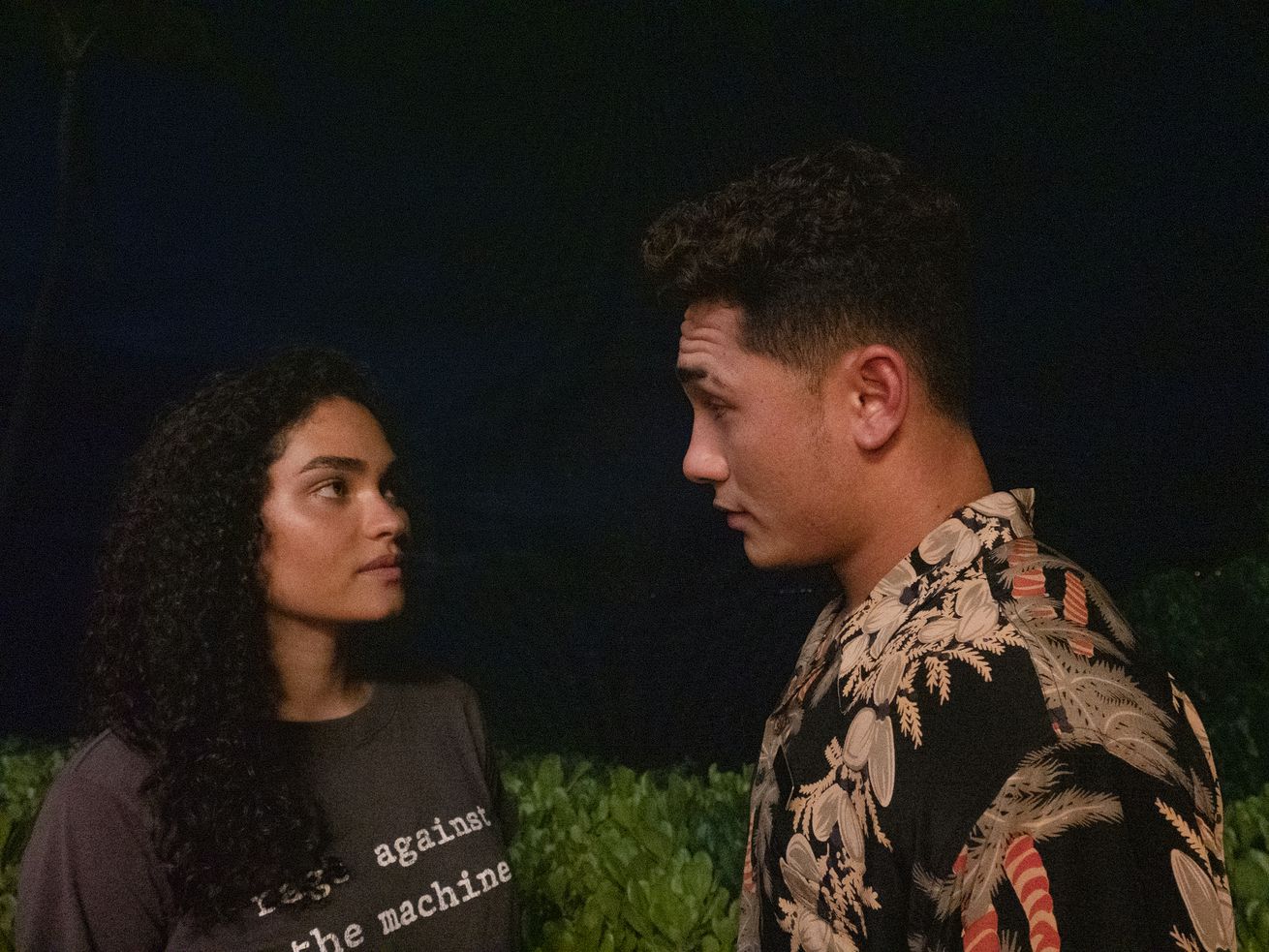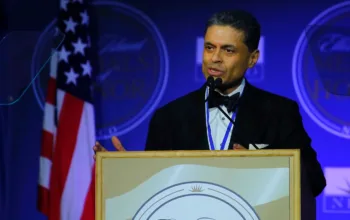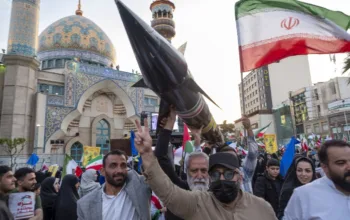The HBO series is a scathing roast of white privilege. But does it realize it succumbs to the same point of view?
Spoilers follow for the first installment of The White Lotus.
As someone born and raised in Hawaii, there are certain Native Hawaiian folk songs that feel capable of time travel. Vivid melodies that transport me to my father’s white truck as he drives me home from volleyball practice, sitting in bumper-to-bumper traffic, his jeans streaked with dry cement. Or waiting backstage to dance at keiki hula competitions, the air humming with tuberose and hibiscus.
Chief among those songs is “Hawai’i Aloha.” Familiar to anyone who’s grown up in Hawaii, the revered Native Hawaiian anthem is sung en masse, our hands interlaced, at the end of concerts and formal gatherings. ʻOli ē! ʻOli ē! A declaration of what it means to be local.
An a cappella version sung by The Rose Ensemble closes the second episode of The White Lotus, HBO’s dark ensemble comedy about rich American tourists vacationing at a luxury resort in Hawaii. The limited six-episode series has been critically acclaimed for poking fun at the excesses of the ultrawealthy, its humor gorging on sarcasm and wit.
So when “Hawai’i Aloha” is used to score a poignant montage right before the credits, it felt like the show’s rare attempt at sincerity: The resort manager, a recovering addict played by Murray Bartlett, has a relapse, while a hapless teen (Fred Hechinger) vacationing at the resort witnesses a whale breaching the water, and something in him blooms. E Hawaiʻi e kuʻu one hānau e, the song starts, or “O Hawaiʻi, O sands of my birth.” My reaction was visceral: a gut punch of nostalgia, followed by excitement that a show set in Hawaii was showcasing Hawaiian music.
But by the second verse, I started to squirm. It was an unsettling feeling that followed me throughout the series, whenever I heard “Aloha ‘Oe,” or Kapona Beamer’s “Hukia Mai A,” or “‘Ohi’a Hua Palaku” by The Sunday Manoa. These songs were employed as counterpoints to composer Cristobal Tapia de Veer’s percussive theme song and score, which brilliantly illuminates the social tensions simmering throughout the show. (He’s described his whirring instrumental compositions as “Hawaiian Hitchcock.”) By contrast, soothing Hawaiian folk songs are employed intermittently as release valves, a way of conjuring the notion of an idyllic Hawaii. But having grown up here, hearing those songs in this context embodied a different sort of tension for me: how Hawaii is often both revered and erased when interpreted through a foreign lens.
Part of my confusion was not always understanding the show’s intentions; in a series that’s purportedly satirizing white privilege, was using Hawaiian music to soundtrack the spiritual epiphanies of entitled tourists meant to be ironic? Or was it intended as a meta-commentary on the continent’s consumption of native land, culture, and people? Is the show that self-aware? If not (and if you have to ask, the answer is probably no), The White Lotus has a different set of problems to contend with, using Hawaiian folk music the way it uses its few Native Hawaiian characters: as hollow plot devices in service of illuminating the inner lives of the series’s mostly white protagonists.
There are two local characters used to bookend the show. The first is a timid White Lotus trainee named Lani (Jolene Purdy), who goes into labor in the middle of her first shift; she doesn’t want to leave work because she needs the money. After giving birth in the hotel manager’s office, she disappears, but the disruption accomplishes a crucial plot point — sending her boss (Bartlett) into a drug-fueled bender. The second is a hunky bellhop and luau performer named Kai (Kekoa Kekumano), who starts a fling with a guest named Paula (Brittany O’Grady). Their relationship is an opportunity for the show to explore issues of Hawaii’s colonization, which it does but only tepidly, via one stilted conversation that feels ham-fisted next to the rest of the show’s dialogue.
Kai and Paula’s chat happens on the beach at dusk, their faces blanketed in shadows, just after the pair have emerged, passionately, from the ocean. We’re four episodes in, but it’s the first time we really hear Kai speak, and he’s feeling nostalgic. He tells Paula about his childhood spent picking seashells, feeding pigs, and pulling taro — a Hawaiian 101 pastiche so basic, I half expected him to break into a spontaneous fire dance. Paula giggles: “You’re just so real.”
Somehow, the conversation pivots to a vague CliffsNotes synopsis of how Hawaiian land was stolen. Kai uses Hawaiian words like lo’i and konohiki, as if Paula knows what they mean. King Kamehameha is mentioned, stripped of any context. Kai is a clumsy and lazy symbol of colonialism in a moment that could have taken greater care to humanize what it means to be Native Hawaiian living in modern Hawaii.
Elsewhere, locals appear as exotic fodder and naive natives to further white characters’ enlightenment. Take one unbelievable scene where Hechinger’s character, Quinn, a 16-year-old gamer who’s developing a spiritual relationship with nature, watches a group of locals paddling in their canoe. “Aloha ’Oe,” the popular Hawaiian anthem written by Queen Liliʻuokalani, soundtracks his awe.
The next day, Quinn approaches the five paddlers who — as welcoming natives stereotypically do — invite him into the canoe. “Man, you one slow haole,” teases one in his pidgin accent, just so you know he’s really local, as Quinn struggles to board. I don’t know if the show realizes it, but the scene — mimicking every corny cinematic depiction of Hawaii, from North Shore to 50 First Dates — is one of The White Lotus’s best claims to satire.
Compared with the tourists, whose lives we follow with intense scrutiny, locals in The White Lotus are reduced to bit parts. This disparity mirrors the current realities faced by Hawaii residents, many of whom feel they are being treated secondary to the needs of visitors. In July, a drought on Maui led to water shortages for upcountry Maui residents, whom county officials threatened with a $500 fine for using water for nonessential activities, like watering their lawns; meanwhile, water usage at resorts and hotels remained unchecked.
Since opening back up to tourism, Covid-19 cases throughout Hawaii have skyrocketed. A month ago, the state was averaging 50 new cases per day, but with tourists visiting at pre-pandemic numbers, that number has jumped to 541. Hotels are once again at capacity, leaving local Covid patients without rooms in which to quarantine.
It’s not that The White Lotus isn’t hilariously successful at illustrating the evils of white privilege and consumption. When O’Grady’s character expresses disgust at having to watch native Hawaiian dancers perform on land that was stolen from them, she’s met with a rich, white shrug. “Obviously, imperialism was bad,” responds Steve Zahn’s character, a sad-sack dad, over dinner. “But it’s humanity. Welcome to history. Welcome to America.” By scraping at imperialism, The White Lotus mimes a moral center but never engages the topic beyond mere gesture. How could it, when the locals and Kānaka Maoli are depicted in only a single dimension?
Showrunner Mike White is certainly aware of the complicated social dynamics at play in a place like Hawaii. After making Enlightened, the cult-favorite HBO show featuring Laura Dern, he bought a house in Hanalei, Kauai. As he recently told the New Yorker:
Mark Zuckerberg has a place there. And I’d be, like, Ugh, those guys. They own the world! And then I was, like, I am that guy. The people who live there [in Hanalei] and have lived there their whole lives, they’re all being displaced. And it’s a small enough place that you can kind of hold it all in your head in a way that you can’t in a place like L.A. It’s a complex place, and I didn’t feel like I could tell the story of the native Hawaiians and their struggles to fight some of their battles, but I felt like I could kind of come at it from the way I experienced it.
That experience — an esteemed, white Hollywood showrunner living part time in Hawaii — feels indicative of The White Lotus’s point of view. It’s good to know your limits, but how successful can a piece of satire be if it replicates the very power structures it purports to satirize? There isn’t a shortage of prestige television shows that take privilege as its muse. But imagine if more took seriously those who bear the brunt of that privilege.
Mitchell Kuga is a freelance writer living in Honolulu.
Author: Mitchell Kuga
Read More



